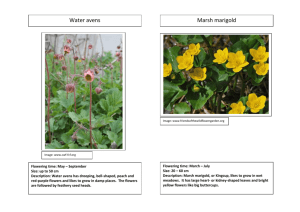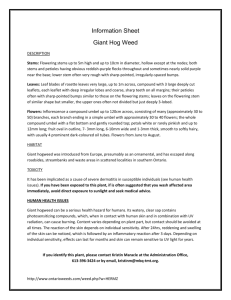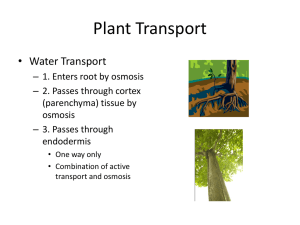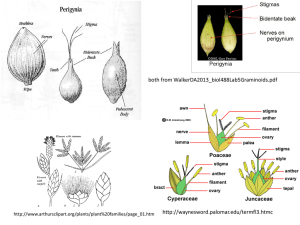4.1 Systems in Plants student copy
advertisement
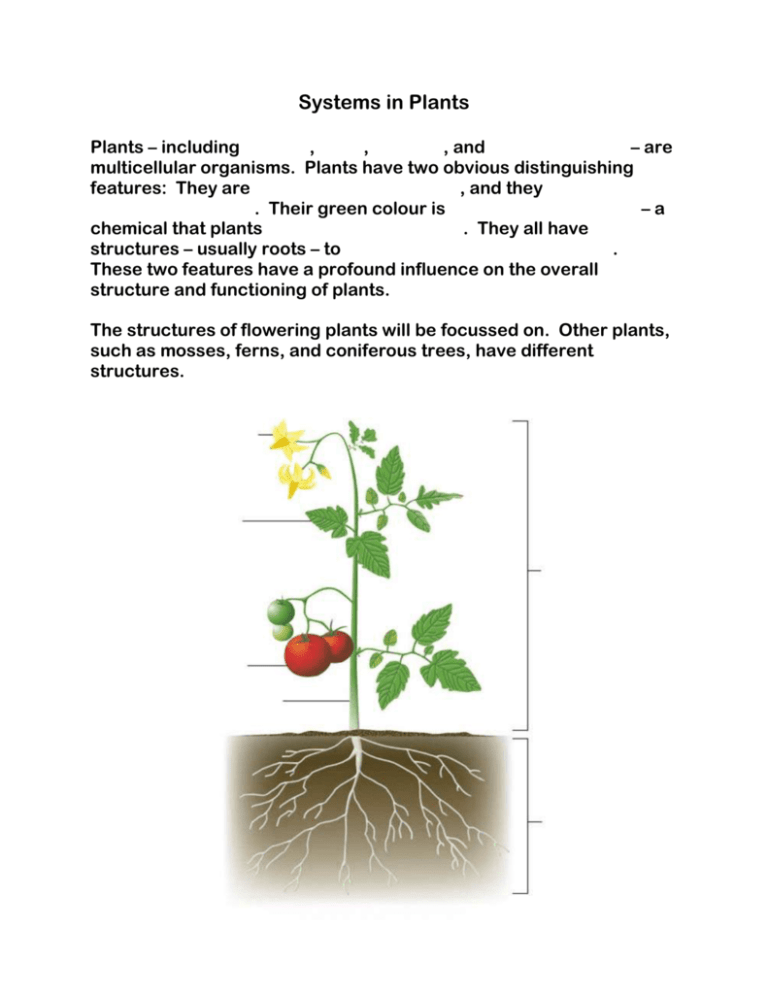
Systems in Plants Plants – including mosses, ferns, conifers, and flowering plants – are multicellular organisms. Plants have two obvious distinguishing features: They are typically green in colour, and they cannot move from place to place. Their green colour is caused by chlorophyll – a chemical that plants use to photosynthesize. They all have structures – usually roots – to anchor them firmly in one place. These two features have a profound influence on the overall structure and functioning of plants. The structures of flowering plants will be focussed on. Other plants, such as mosses, ferns, and coniferous trees, have different structures. The plant body is divided into two main “body systems.” This contrasts strikingly with animals, which are made up of many systems. Plants perform photosynthesis to make their own food. This means that they do not need to move around in search of food. As a direct consequence, they have no need for the complex and coordinated organ systems found in animals. A plant does not require a digestive or musculoskeletal system or a nervous system to sense its surroundings and coordinate movements. However, plants do have to perform many of the same functions as animals: Plants need to exchange gasses with their surroundings. They require an internal transportation system to move water and nutrients around within their bodies. They must have a way of reproducing. The flowering plant body has two main body systems: the root system and the shoot system. These systems consist of a number of structures. The root system is made up of one or more separate roots, whereas the shoot system consists of the stem, leaves, and flowers (when present). Plant parts are made up of a wide variety of specialized cells. As in animals, groups of similar specialized cells are called tissues. In addition to the plant’s two main body systems, scientists also refer to their tissues as belonging to separate systems. There are three main types of plant tissue systems: the dermal tissue system, the vascular tissue system, and the ground tissue system. The dermal tissue system is made up of tissues that form the outer surfaces of plant parts. The vascular tissue system is made up of tissues specialized for the transportation of water, minerals, and nutrients throughout the plant. The tissues in the ground tissue system make up all of the other structures within a plant. THE ROOT SYSTEM The part of the plant that typically grows below ground. The root system anchors the plant, absorbs water and minerals from the soil, and stores food. Most of the water and minerals obtained by the plant are absorbed by root hairs: fine extensions of dermal tissue cells. A plant’s root system can spread underground to cover a very large area. Some roots even appear above ground or above water. Other roots, such as radishes and carrots, are specialized for nutrient storage. Roots have long been a useful source of foods (sweet potatoes, carrots, sugar beet), flavourings (liquorice, ginger), fibres (used in basketry), and a variety of natural remedies. THE SHOOT SYSTEM The system that is specialized for two main functions: To conduct photosynthesis and to produce flowers for sexual reproduction. The shoot systems of flower plants are made up three parts – the leaf, the flower, and the stem – which all have distinctive functions THE LEAF The main photosynthetic structure of the plant. In photosynthesis, tissues in the leaf use carbon dioxide, water, and light energy to produce glucose (a form of sugar) and oxygen. The glucose is used for plant growth, cellular respiration, and energy storage. Light Energy + CO2 + H2O C6H12O6 + O2 The cell structure that actually performs photosynthesis is an organelle called a chloroplast. Chloroplasts contain flat, disc-like structures called thylakoids. Thylakoids are arranged in stacks called grana. These stacks act as solar collectors, using chlorophyll in the membranes of the thylakoids. Some leaves are also adapted for support, protection, reproduction, and attraction. We use leaves in a variety of ways. Many are edible, such as lettuce, spinach, onion, tea, and herbs. Others are sources of waxes and medicines. THE FLOWER Flowers are specialized structures developed for sexual reproduction. They contain male or female reproductive structures or sometimes both. Male reproductive structures produce pollen grains; female reproductive structures produce eggs. Eggs are fertilized by pollen. After pollination, the female flower parts form seeds. In most flowering plants, the seeds are contained within a specialized structure called a fruit. Pollination occurs with the help of wind or animals. Flowering plants such as grasses and many common tree species are wind pollinated. The flowers are small and drab but produce large amounts of pollen. In contrast, other flowering plants are pollinated by animals, such as insects, bats, and birds. These plants often have large, colourful, and fragrant flowers to attract their would-be pollinators. Most also produce nectar as an added form of attraction. Flowers, and the seeds and fruits that come from them, are very important sources of food and flavourings. Rice, wheat, corn, vanilla, chocolate, coffee, bananas, apples, mangos, cotton, and even some medicines all originate from flowers. THE STEM The flowering plant stem (or trunk in the case of trees) has several functions. It supports the branches, leaves, and flowers and provides a way to transport materials. The stem contains significant amounts of vascular tissue for carrying substances to and from roots, leaves, flowers, and fruits. Some stems are specialized for food storage, protection, photosynthesis, and reproduction. Plant stems provide us with sugar, potatoes, wood, and paper products, cork, linen and a variety of medicines

